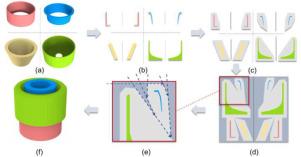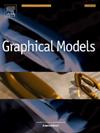Carvable packing of revolved 3D objects for subtractive manufacturing
IF 2.2
4区 计算机科学
Q2 COMPUTER SCIENCE, SOFTWARE ENGINEERING
引用次数: 0
Abstract
Revolved 3D objects are widely used in industrial, manufacturing, and artistic fields, with subtractive manufacturing being a common production method. A key preprocessing step is to maximize raw material utilization by generating as many rough-machined inputs as possible from a single stock piece, which poses a packing problem constrained by tool accessibility. The main challenge is integrating tool accessibility into packing. This paper introduces the carvable packing problem for revolved objects, a critical but under-researched area in subtractive manufacturing. We propose a new carvable coarsening hull and a packing strategy that uses beam search and a bottom-up placement method to position these hulls in the stock material. Our method was tested on diverse sets of revolved objects with different geometries, and physical tests were conducted on a 5-axis machining platform, proving its ability to enhance material use and manufacturability.

用于减法制造的旋转三维物体的可切割包装
旋转三维物体广泛应用于工业、制造业和艺术领域,减法制造是一种常见的生产方法。一个关键的预处理步骤是通过从单个库存件中产生尽可能多的粗加工输入来最大化原材料利用率,这就产生了受工具可及性限制的包装问题。主要的挑战是将工具的可访问性集成到包装中。本文介绍了旋转物体的可切割填充问题,这是减法制造中一个关键但研究较少的领域。我们提出了一种新的可切割粗化船体和包装策略,使用光束搜索和自下而上的放置方法来定位这些船体在库存材料中。我们的方法在不同几何形状的多组旋转物体上进行了测试,并在五轴加工平台上进行了物理测试,证明了其提高材料利用率和可制造性的能力。
本文章由计算机程序翻译,如有差异,请以英文原文为准。
求助全文
约1分钟内获得全文
求助全文
来源期刊

Graphical Models
工程技术-计算机:软件工程
CiteScore
3.60
自引率
5.90%
发文量
15
审稿时长
47 days
期刊介绍:
Graphical Models is recognized internationally as a highly rated, top tier journal and is focused on the creation, geometric processing, animation, and visualization of graphical models and on their applications in engineering, science, culture, and entertainment. GMOD provides its readers with thoroughly reviewed and carefully selected papers that disseminate exciting innovations, that teach rigorous theoretical foundations, that propose robust and efficient solutions, or that describe ambitious systems or applications in a variety of topics.
We invite papers in five categories: research (contributions of novel theoretical or practical approaches or solutions), survey (opinionated views of the state-of-the-art and challenges in a specific topic), system (the architecture and implementation details of an innovative architecture for a complete system that supports model/animation design, acquisition, analysis, visualization?), application (description of a novel application of know techniques and evaluation of its impact), or lecture (an elegant and inspiring perspective on previously published results that clarifies them and teaches them in a new way).
GMOD offers its authors an accelerated review, feedback from experts in the field, immediate online publication of accepted papers, no restriction on color and length (when justified by the content) in the online version, and a broad promotion of published papers. A prestigious group of editors selected from among the premier international researchers in their fields oversees the review process.
 求助内容:
求助内容: 应助结果提醒方式:
应助结果提醒方式:


